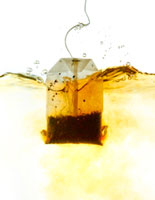Hemodialysis - Why More is Better
All dialysis centers are not alike. Some are better than others. And all forms of dialysis are not equal. Some treatments are better than others, too. The more you know about how dialysis works, the better able you'll be to find care that will let you live the best life you can.
More dialysis is better for your health. If you get more treatment, you'll feel better, have fewer diet and fluid limits, your heart will stay stronger, and you may live longer. Why? Read on.
Removing Water

Healthy kidneys remove excess water as urine. Once they fail, dialysis removes some excess water from your blood and tissues. This is not as easy as it may sound.
Your body is mostly—60%—water, which can be found in three "spaces:"
- Intracellular space
- in your cells
- Interstitial space
- between your cells
- Intravascular space
- in your bloodstream
Dialysis can only remove water that is in your bloodstream. As water comes out of your blood, water from between your cells seeps in to make up for what has been lost. This takes time. If a hemodialysis (HD) treatment is too short, the water won't have enough time to move into your bloodstream. You may have swelling or a hard time breathing.
An HD dialyzer is packed with hollow fibers, each thinner than a hair. The fibers are a semipermeable membrane. Small wastes pass through pores in the membrane; large wastes, like proteins, can't fit through the pores. During HD, blood flows through the insides of the fibers. Dialysate, a mix of purified water and salts, flows around the outside of the fibers. Water is pulled out of the blood and into the dialysate by a pump. This way to remove water is called ultrafiltration (UF).
The Value of Time

Most in-center HD takes off the water you gained since your last treatment—45 to 69 hours worth—in 3-4 hours. In the short term, gaining a lot of water and pulling it off in 3 hours is hard on you. If your blood pressure drops, you may have cramps, headaches, feel dizzy, throw up, or pass out.1 For the rest of the day, you may feel washed out or like you have the flu. You have strict salt and fluid limits, because the short treatments can only do so much.
In the long term, standard in-center HD is hard on your heart. Studies have found that 911 calls for CPR,2 heart attacks,3 and sudden heart deaths4 were highest after the 2-day break. Having your fluid levels "yo-yo" up and down three times a week may cause high blood pressure or make it worse. Blood pressure pills may not control it well. High blood pressure can harm your heart and raise your risk of a heart attack, stroke, or blindness.

Two other ways to do HD let you drink more fluid and are better for your heart:
With short daily HD (2.5-4 hour treatments 5-6 days per week), you have just 22 hours between treatments on most days. You gain less, so you take off less water at each treatment. This is gentler on your heart, and your salt and fluid limits don't have to be as strict. A study of 192 patients on short daily HD found that they lived much longer than those on standard HD.5 A study of 405 patients found that 68% (+/- 4%) lived for at least 5 years on short daily HD, vs. 31% of in-center HD patients the same age.6 A national, random study found that compared to standard HD, those who did short daily treatments:
- Had healthier hearts
- Felt better physically
- Had lower blood pressure and phosphorus
In most places, short daily HD is a home treatment only.
Extended HD (8 hour treatments 3-6 times per week) is twice as much treatment—or more—as standard HD. Most people do these long treatments at night. (They may be called "nocturnal.") More HD feels more like having healthy kidneys.
- Treatments are slow and very gentle. They remove water with far less strain on your heart.7
- Done 6 nights per week, extended HD helps blood vessels stay supple, which lowers blood pressure.8 Most patients don't need blood pressure pills.
- Extended HD removes so much phosphorus (about 45% more9) that some patients need to take phosphate supplements instead of binders.
- You may not need any salt or fluid limits.
Extended HD may be done at home or in some centers.
Removing Wastes

The other key task of dialysis is to remove wastes that build up in your blood each day. Most wastes are removed by diffusion. The membrane in the dialyzer is semipermeable. A tea bag is a good way to think about this. Small particles can pass through (tea), but bigger ones can't (tea leaves).
Wastes in your blood pass through the membrane in your dialyzer. There are no wastes in the dialysate fluid. So, wastes in your blood diffuse into the dialysate and out of your body. Diffusion goes on until both sides of the membrane have the same level of wastes. But, in HD, fresh dialysate is always flowing in. Diffusion goes on as long as the treatment lasts.
Wastes vary in size (or molecular weight). Small wastes pass through the membrane much faster than larger ones, like "middle molecules." Proteins and blood cells are too big to fit through the membrane
We'll look at three wastes, below: urea, phosphorus, and beta-2 microglobulin (B2M):
- Urea
- A protein waste that is removed by healthy kidneys. It is measured as blood urea nitrogen (BUN). Most urea comes out in the first hour or two of HD. Short daily treatments remove more urea than standard HD because you get more "first hours" of treatment. Extended (nocturnal) HD also removes more urea, because there is just so much more time to remove wastes of any size.
-
 Phosphorus
Phosphorus
- A mineral that is found in most foods. With calcium, it forms the bulk of your bones and teeth. In the short term, if you have too much phosphorus in your blood, you may itch. In the long term, high levels can harm your bones, heart, and blood vessels. Standard HD removes up to 70% of your excess phosphorus.10 To get rid of more, you need phosphate binders. But, binders made of calcium can add to calcification of your soft tissues, blood vessels, and heart valves.11 They turn to stone! During the 2-day treatment gap, blood levels of calcium and phosphorus rise in people who take these binders, which can make calcification worse.12 Binders made with no calcium work better, but cost much more. Extended HD removes far more phosphorus than standard HD. Most who use it don't need to take binders. Some even need phosphate supplements.13 In one patient, large calcium lumps melted away after 9 months of daily extended HD.14 Since both short daily or extended HD remove more wastes, they have fewer diet limits than standard HD, too.
- Beta-2 microglobulin (B2M)
- Part of a form of amyloid, a waxy protein. In time, it can build up in the blood of people on dialysis and form lumps in the body ( amyloidosis ). Often, B2M goes to the joints, which can cause pain and make it hard to move (such as carpal tunnel syndrome). Lumps can also form in blood vessels, on organs, or even in the eyes or skin. B2M is a "middle molecule;" one that takes a long time to remove. The 3-4 hours of standard HD are not long enough to remove much B2M. Extended HD does a better job.15
It's Common Sense
When your kidneys were healthy, they worked 24 hours a day, 7 days a week (168 hours a week). Your heart and lungs don't work for only a few hours 3 days a week; why should your dialysis? Longer and/or more frequent treatments do a better job of removing both water and wastes. People who do longer or more frequent treatments say they:
- Feel better, have more energy, and are less tired
- Have more good days with fewer ups-and-downs
- Eat better, including more fruits and vegetables
- Return to a normal skin color
- Have more free time for work or play and more control over their lives
- Sleep better at night and have better sexual function
The Time-Life Trade-off

You are the only one who can say whether the benefits of more HD are worth the costs in training time and extra responsibility. Even if one of these options won't fit your life right now, keep them in mind for the future. You can always change your mind about the type of treatment you do.
The goal of dialysis is to make you feel as well as you can so you can keep doing what you love. If, at any time, that's not true, look at your options. You may be able to feel better.
References:
- Hossli SM. Clinical management of interdialytic hypotension: survey results. Nephrol Nurs J. May-Jun;(32)3:287-91, quiz 292, 2005
- Lafrance JP, Nolin L, Senecal L, Leblanc M. Predictors and outcome of cardiopulmonary resuscitation (CPR) calls in a large haemodialysis unit over a seven-year period. Nephrol Dial Transplant. Dec 29; [epub ahead of print]
- Karnik JA, Young BS, Lew NL, Herget M, Dubinsky C, Lazarus JM, Chertow GM. Cardiac arrest and sudden death in dialysis units. Kidney Int. Jul;60(1):350-7, 2001
- Bleyer AJ, Russell GB, Satko SG. Sudden and cardiac death rates in hemodialysis patients. Kidney Int. Apr;55(4):1553-9, 1999
- Blagg CR, Kjellstrand CM, Ting GO, Young B. Short daily hemodialysis standardized mortality ratios, 2003 and 2004. J Am Soc Nephrol. 16:723A, 2005
- Kjellstrand C, Buoncristiani U, Ting G, Traeger J, Piccoli GB, Sibai-Galland R, Young B, Blagg CR. Survival in 405 patients treated by short daily hemodialysis (DHD) for 948 patient years rivals renal transplant survival. J Am Soc Nephrol. 16:723A, 2005
- Yuen D, Chan CT. Inflammation, cardiovascular disease and nocturnal hemodialysis. Curr Opin Nephrol Hypertens. Nov;14(6):538-42, 2005
- Chan CT, Jain V, Picton P, Pierratos A, Floras JS. Nocturnal hemodialysis increases arterial baroreflex sensitivity and compliance and normalizes blood pressure of hypertensive patients with end-stage renal disease. Kidney Int. Jul;68(1):338-44, 2005
- Agar BU, Troidle L, Finkelstein FO, Kohn FO, Akonur A, Leypoldt JK. Patient-specific phosphorus mobilization clearance during nocturnal and short daily hemodialysis. Hemodial Int. 2012 Oct;16(4):491-6
- Ritz E. The clinical management of hyperphosphatemia. J Nephrol. May-June;18(3):221-8, 2005
- Asmus HG, Braun J, Krause R, Brunkhorst R, Holzer H, Schulz W, Neumayer HH, Raggi P, Bommer J. Two year comparison of sevelamer and calcium carbonate effects on cardiovascular calcification and bone density. Nephrol Dial Tranpslant. Aug;20(8):1653-61, 2005
- Sigrist MK, Devlin L, Taal MW, Fluck RJ, McIntyre CW. Length of interdialytic interval influences serum calcium and phosphorus concentrations. Nephrol Dial Transplant. Aug;20(8):1643-6, 2005
- Schulman G. Nutrition in daily hemodialysis. Am J Kidney Dis. Mar;41(3 Suppl 1):S112-5, 2003
- Kim SJ, Goldstein M, Szabo T, Pierratos A. Resolution of massive uremic tumoral calcinosis with daily nocturnal home hemodialysis. Am J Kidney Dis. Mar;41(3):E12, 2003
- Raj DS, Ouwendyk M, Francoeur R, Peirratos A. beta(2)-microglobulin kinetics in nocturnal haemodialysis. Nephrol Dial Transplant. Jan;15(1):58-64, 2000

